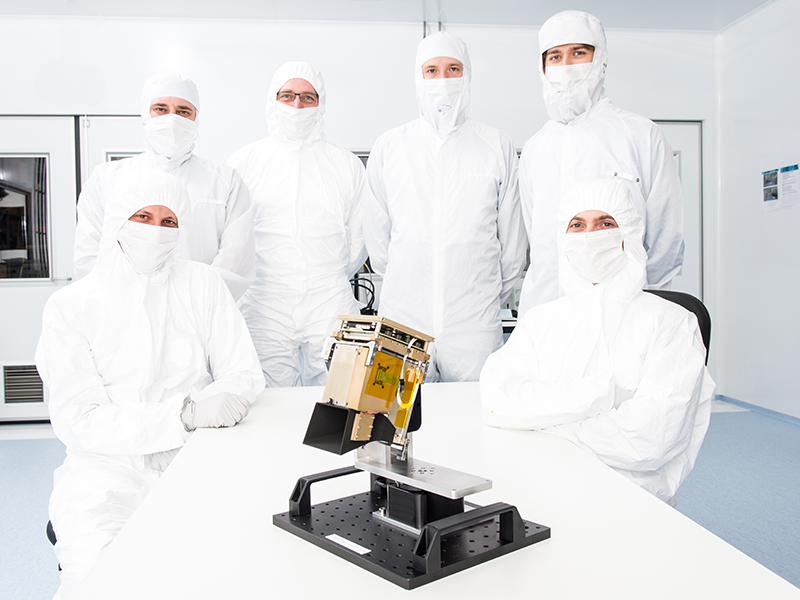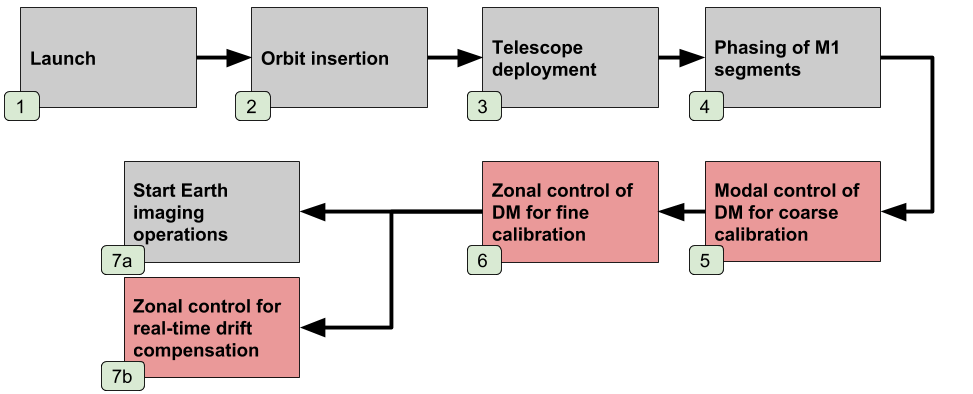Spacecraft engineering
Up and beyond. Engineering for the space environment brings unique technical challenges. On this page I'd like to share two experiences with spacecraft engineering and testing.
Hyperscout test campaign at cosine
After my Bsc in Aerospace Engineering at Delft University of Technology, I continued with the Msc track in Space Systems Engineering. During this master, I prepared and performed space hardware tests during a six-month internship at cosine for their Hyperscout-1 project. This instrument is a hyperspectral camera for use in cubesats.
To be qualified for launch, we tested the instrument for mechanical shock and vibration. To simulate the space environment, I prepared and performed thermal-vacuum tests which were successfully passed.

The hyperscout-1 development team. I am top-right in this picture. Image credits and copyright cosine.

Optical design by Dolkens. Light from Earth arrives at the primary mirror (M1) from the left and is focussed on the detectors. Optical aberrations can be removed with the Deformable Mirror (DM).
Thesis research: deformable mirrors in a space telescope
During my Msc thesis, I performed research on the simulation of deformable mirrors for use in space telescopes. More specifically, I simulated how a deformable mirror can be tuned in real-time with a stochastic gradient optimization algorithm to achieve high image quality. With this method, no extra wavefront detection hardware is required to control the mirror. The optical model and optical simulation is based on the deployable space telescope design from Dolkens.
My Msc thesis, titled "Design of an Aberration Correction System for a Deployable Space Telescope" (2018) was rewarded with a grade 9/10. It can be downloaded here.
A part of this work has been incorporated in a paper from Dolkens, Van Marrewijk, Kuiper, which can be retrieved here.

After being launched (1) into orbit (2), the telescope mirrors deploy (3). The primary mirror segments are phased to act as one mirror (4). After this step, residual aberrations are removed with the deformable mirror during step 5 and 6. Finally, during operations, thermal drift which affects the optical components can be compensated with continuous optimization of the deformable mirror shape.
Simulated wavefront travel of light through the DST optics. An exaggerated wavefront aberration is introduced. The green deformable mirror needs to counteract this aberration.
Modal Deformable Mirror (DM) actuation simulation for the Zernike modes, using push-pull actuator forces to a metal sheet. Red vectors indicate the actuator stroke if no plate stiffness would be present.
Zonal DM actuation simulation. The effect of individual push-pull actuators is studied. Red vectors indicate the actuator stroke if no plate stiffness would be present.
DM modal calibration simulation. The DM is distorted with a stochastic gradient descent algorithm. Control variables are the Zernike modes. If the simulated image sharpness increases between the first detector (TDI1) and the second (TDI2), the change was positive and a control step is taken in the randomly generated control vector. A negative change in sharpness leads to a negative scaling of the random step. In this way, the image quality improves without an explicit wavefront sensor.
DM zonal calibration simulation. The DM is distorted with a stochastic gradient descent algorithm. Control variables are the individual actuators. If the simulated image sharpness increases between the first detector (TDI1) and the second (TDI2), the change was positive and a control step is taken in the randomly generated control vector. A negative change in sharpness leads to a negative scaling of the random step. In this way, the image quality improves further but slower than with the modal control described above.
After calibration, thermal drifts may degrade image quality as demonstrated in this simulation.
By applying active drift compensation with the DM, image quality can be kept high. The gradient descent optimization makes random and microscopic disturbance steps and is sensitive enough to use these steps to detect the direction of continuous drift compensation.